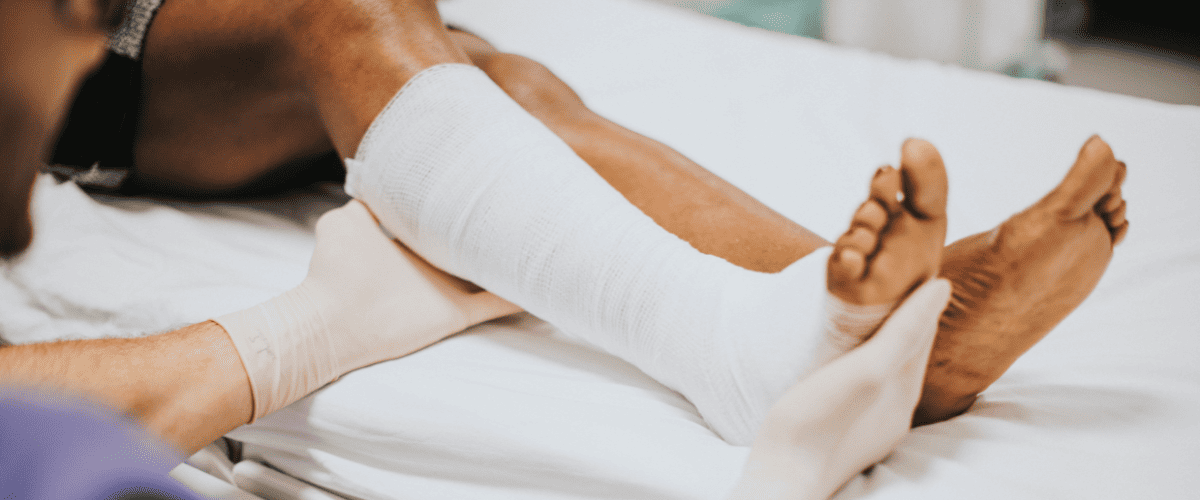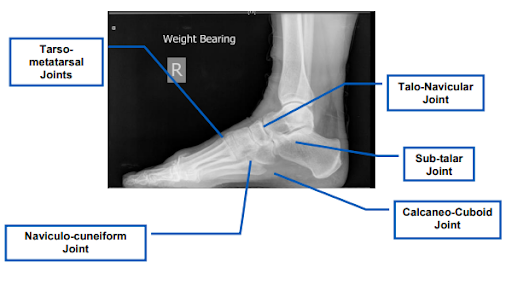
15 Jul Foot Fusion Surgery: Is It the Right Choice for Severe Arthritis?
Foot Fusion Surgery: Is It the Right Choice for Severe Arthritis?
By Island Hospital | July 16, 2025 10:30:00 AM
Foot fusion surgery is a life-changing procedure for people suffering from chronic foot pain, instability, or deformities that don’t improve with conservative treatments.
It offers lasting relief by joining bones together to reduce movement in damaged joints — often easing pain and improving quality of life.
While it’s not the right solution for everyone, foot fusion has helped many patients regain function and comfort in daily life.
In this article, you’ll find information on the types, who’s a good candidate, what to expect before and after surgery, and how it affects mobility and footwear.
What is Foot Fusion Surgery?
Foot fusion surgery, or arthrodesis, involves permanently joining two or more bones in the foot so they heal into a single solid bone.
By eliminating movement in painful or arthritic joints, the procedure reduces pain, improves stability, and restores foot alignment. It’s commonly performed on patients with arthritis, flatfoot, midfoot collapse, or after trauma.

Joints which may be included in midfoot and hindfoot fusion surgery (Source: NHS).
Struggling with joint pain and stiffness from arthritis? Read our complete guide to management and treatment of rheumatoid arthritis.
Types of Foot Fusion Surgery
Depending on the type and severity of your condition, your doctor may recommend one of the following:
- Ankle Fusion (Tibiotalar Arthrodesis): Fuses the shinbone to the ankle bone to address severe arthritis or instability.
- Subtalar Fusion: Fuses the joints below the ankle, often done for flatfoot or post-traumatic arthritis.
- Midfoot Fusion: Targets joints in the middle of the foot, often used for arthritis, collapse, or deformities.
- Triple Fusion: A more extensive procedure that fuses three major foot joints to treat severe deformities or arthritis.
- Toe Joint Fusion: Often used for hammertoes or severe arthritis in the big toe (hallux rigidus).
Candidacy Checklist for Foot Fusion Surgery
When is Foot Fusion Considered?
Foot fusion is considered for the following conditions:
- Severe arthritis unresponsive to non-surgical treatments
- Chronic foot pain affecting mobility
- Foot deformities (e.g. flatfoot, midfoot collapse)
- Joint instability due to injury or degeneration
The Ideal Candidate
To ensure a good outcome, you should:
- Be a non-smoker with good circulation
- Have realistic expectations about mobility after fusion
- Be motivated to complete post-operative recovery and therapy
Who Might Not Be a Good Candidate?
You might need to reconsider if you:
- Have poor blood flow or nerve damage in the foot
- Have active infections
- Require high flexibility for specific activities (e.g. athletes, dancers)
Foot Fusion Vs. Alternatives
To see how foot fusion compares with alternatives, refer to the table below:
| Aspect | Foot Fusion | Joint Replacement | Orthotics/Bracing |
|---|---|---|---|
| Ideal For | Severe arthritis or deformities | Select ankle arthritis cases | Early arthritis or post-injury support |
| Goal | Relieve pain by stopping joint movement | Relieve pain while preserving motion | Support alignment and reduce pain |
| Permanency | Permanent | May need revision after years | Temporary/non-surgical |
| Mobility Impact | Reduced in fused joint | Preserved | Preserved |
| Recovery Time | 3-6 months | 6-12 months | Minimal |
| Durability | Very durable | Limited lifespan (10-15 years) | Depends on usage |
What to Expect From Surgery to Recovery
In this section, we’ll cover what to expect from surgery preparation to the procedure itself:
Preparing for Surgery
You’ll undergo imaging tests and medical clearance beforehand. Your surgeon may advise you to stop smoking, adjust medications, or use crutches in advance to reduce post-op complications. Planning for help at home and work is essential, as walking will be limited during recovery.
The Surgical Procedure
The procedure usually takes around two hours. However, this can change depending on the severity of damage to your foot and number of joints involved,
- Step 1: Anesthesia Administration
You’ll be placed under general anesthesia or receive spinal anesthesia with sedation to ensure you feel no pain during surgery. - Step 2: Sterilisation and Positioning
The surgical area is cleaned and sterilised, and your foot is positioned for the best access to the affected joint. - Step 3: Incision
The surgeon makes a small incision over the joint being fused to expose the underlying bones. - Step 4: Removal of Damaged Joint Surfaces
Cartilage and any diseased tissue are removed from the joint surfaces to prepare the bones for fusion. - Step 5: Bone Alignment and Grafting
The bones are precisely aligned in the optimal position. Bone graft material — either from your body or a donor — is added to promote fusion. - Step 6: Internal Fixation
Screws, plates, or rods are inserted to hold the bones securely together while the fusion takes place. - Step 7: Closure
The incision is closed with sutures or staples, and the area is bandaged to protect it from infection. - Step 8: Postoperative Immobilisation
A splint or cast is applied immediately after surgery to keep the foot immobile and protect the fusion site.
Recovery Timeline
| Stage | What to Expect |
|---|---|
| Week 1-2 | Foot is in a cast or splint, elevated at all times, non-weightbearing |
| Week 3-6 | Sutures removed, swelling reduces, transition to removable boot |
| Week 6-12 | Begin partial weight-bearing with guidance, start physical therapy |
| 3-6 Months | Gradual return to regular activities, continued improvement in pain |
| 6+ Months | Most bone fusion is complete, walking becomes more comfortable |
Life After Fusion: Embracing New Mobility and Footwear
How Foot Fusion Surgery Impacts Mobility
While the fused joint will no longer move, most patients adapt well and can walk, climb stairs, and drive without major issues. Pain relief and improved stability usually outweigh the loss of motion in the affected joint.
Practical Footwear Choices
Your orthopaedic specialist will recommend:
- Supportive Shoes: Look for stiff soles and arch support to reduce pressure on the foot.
- Custom Orthotics: These can help redistribute weight and improve comfort.
- Avoid High Heels or Soft Soles: These can strain the fused area or cause instability.
Adapting to a “Stiff” Joint
You may notice some limitations in range of motion, especially during uneven walking or high-impact activities. However, most people develop natural compensations and learn to move comfortably with a stiffer foot.
Tips for a Faster Recovery
Here are some tips to ensure a faster and better recovery:
- Follow Weight-Bearing Instructions Exactly
Your surgeon will tell you when it’s safe to start putting weight on your foot—don’t rush this. Walking too early can disrupt the fusion process and lead to complications or delayed healing.
- Keep Your Foot Elevated
Elevation helps reduce swelling, especially in the first few weeks. Aim to keep your foot above heart level for several hours a day, particularly when resting or sleeping.
- Don’t Skip Physical Therapy
Physical therapy helps you regain strength, balance, and mobility in surrounding joints. Sticking to your therapist’s plan accelerates recovery and prevents long-term stiffness.
- Eat a Bone-Healing Diet
Prioritise foods rich in calcium, vitamin D, and protein—like dairy, leafy greens, eggs, and lean meat. These nutrients support bone healing and overall tissue repair.
- Avoid Smoking and Alcohol
Smoking restricts blood flow and can significantly slow bone healing. Alcohol may interfere with medications and your body’s inflammatory response, so both should be limited or avoided.
- Take Medications as Prescribed
Pain medications, antibiotics, and blood thinners are typically part of your post-op plan. Take them exactly as directed to manage discomfort, prevent infection, and reduce clotting risk.
- Keep the Surgical Site Clean and Dry
Proper wound care lowers the risk of infection. Follow all hygiene instructions, and avoid getting your cast or dressing wet unless you’re cleared to shower with protection.
- Use Mobility Aids Correctly
Whether you’re on crutches, a knee scooter, or a walker, make sure you’re using them safely and consistently. This keeps pressure off your healing foot and reduces the risk of falls.
- Stay Positive and Patient
Recovery is gradual and can feel frustrating, but emotional resilience and patience make a big difference. Set realistic goals and celebrate progress along the way, even small ones.
Reclaim Your Mobility With a Foot Fusion Surgery at Island Hospital
Foot fusion surgery is a major decision, but for the right candidate, it can offer long-lasting pain relief and better stability.
With proper preparation, recovery, and support, most patients find that the trade-off in joint flexibility is well worth the gain in everyday comfort and function.
For those considering this transformative surgery or seeking expert care for any orthopaedic concern, Island Hospital is your premier destination.
Our team of orthopaedic professionals brings over 65 years of combined experience to every case, allowing us to tackle even the most complex spinal conditions with confidence and precision.
This commitment to excellence has led to our recognition as a finalist in Malaysia’s Flagship Medical Tourism Hospital Programme and a place on Newsweek’s lists of World’s Best Hospitals 2025 and Best Specialised Hospitals Asia Pacific 2024 (Orthopaedic).
Don’t let knee pain or any orthopaedic issue hold you back any longer. Take the first step towards reclaiming your mobility and quality of life by booking an appointment with our expert team today.
For any inquiries, please don’t hesitate to contact us!
FAQ
Is foot fusion worth it?
Foot fusion can be worth it for patients with severe arthritis or deformities, as it relieves pain and improves stability. However, it does reduce flexibility in the fused joint, so the decision depends on individual needs and lifestyle.
How long does a foot fusion surgery take?
Foot fusion surgery typically takes 2 to 3 hours, depending on the complexity and number of joints involved. Your surgeon may also account for prep and recovery time in the operating room.
Do I have to stay overnight for a midfoot fusion?
Most patients stay at least one night in the hospital after a midfoot fusion to manage pain and monitor recovery. In some cases, it may be done as an outpatient procedure if deemed safe by your doctor.
Is physical therapy necessary after a foot fusion surgery?
Yes, physical therapy is often recommended after foot fusion surgery to help restore strength, balance, and proper walking mechanics. It also aids in reducing stiffness and improving overall function during recovery.
How do you sleep after foot fusion surgery?
You’ll need to keep your foot elevated above heart level to reduce swelling, usually by propping it on pillows. Sleeping on your back with your leg supported is often the most comfortable and safe position.






